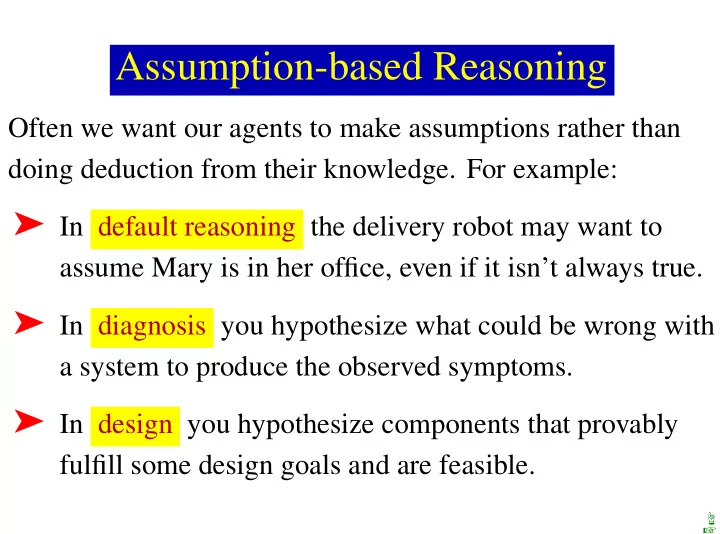

Assumption-based Reasoning Often we want our agents to make assumptions rather than doing deduction from their knowledge. For example: ➤ In default reasoning the delivery robot may want to assume Mary is in her office, even if it isn’t always true. ➤ In diagnosis you hypothesize what could be wrong with a system to produce the observed symptoms. ➤ In design you hypothesize components that provably fulfill some design goals and are feasible. ☞ ☞
Design and Recognition Two different tasks use assumption-based reasoning: ➤ Design The aim is to design an artifact or plan. The designer can select whichever design they like that satisfies the design criteria. ➤ Recognition The aim is to find out what is true based on observations. If there are a number of possibilities, the recognizer can’t select the one they like best. The underlying reality is fixed; the aim is to find out what it is. Compare: Recognizing a disease with designing a treatment. Designing a meeting time with determining when it is. ☞ ☞ ☞
The Assumption-based Framework The assumption-based framework is defined in terms of two sets of formulae: ➤ F is a set of closed formula called the facts . These are formulae that are given as true in the world. We assume F are Horn clauses. ➤ H is a set of formulae called the possible hypotheses or assumables. Ground instance of the possible hypotheses can be assumed if consistent. ☞ ☞ ☞
Making Assumptions ➤ A scenario of � F , H � is a set D of ground instances of elements of H such that F ∪ D is satisfiable. ➤ An explanation of g from � F , H � is a scenario that, together with F , implies g . D is an explanation of g if F ∪ D | = g and F ∪ D �| = false . A minimal explanation is an explanation such that no strict subset is also an explanation. ➤ An extension of � F , H � is the set of logical consequences of F and a maximal scenario of � F , H � . ☞ ☞ ☞
Example a ← b ∧ c . b ← e . ➤ { e , m , n } is a scenario. b ← h . ➤ { e , g , m } is not a scenario. c ← g . ➤ { h , m } is an explanation for a . c ← f . ➤ { e , h , m } is an explanation for a . d ← g . ➤ { e , h , m , n } is a maximal scenario. false ← e ∧ d . ➤ { h , g , m , n } is a maximal scenario. f ← h ∧ m . assumable e , h , g , m , n . ☞ ☞ ☞
Default Reasoning and Abduction There are two strategies for using the assumption-based framework: ➤ Default reasoning Where the truth of g is unknown and is to be determined. An explanation for g corresponds to an argument for g . ➤ Abduction Where g is given, and we are interested in explaining it. g could be an observation in a recognition task or a design goal in a design task. ☞ ☞
Recommend
More recommend